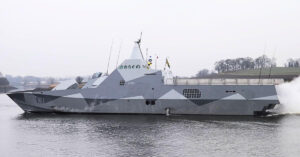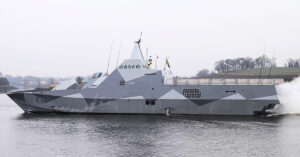
Divers Discover Rare 200-Year-Old Shipwreck With Masts Still Standing In Lake Ontario
November 25, 2025
Captain Of Grounded Ferry Never Entered Bridge While Navigating Hazardous Channel Over 1,000 Times
November 25, 2025

Sweden expects to decide early next year which supplier will build its new Luleå-class frigates, a major multi-billion-crown programme that will deliver the country’s largest surface warships in almost half a century.
Defence Minister Pål Jonson said during a briefing in Stockholm that the government aims to finalise the choice at the start of 2026. He explained that Sweden is examining available designs that can fit the accelerated schedule, as the first two frigates are planned to enter service around 2030.
Given the tight timeline, Sweden has opted to focus on existing foreign designs rather than pursue a new domestic development. The Defence Materiel Administration (FMV) has already completed a market survey and is now reviewing shortlisted alternatives. The remaining two frigates are expected to follow into service by 2035.
The new Luleå-class ships will replace the smaller Visby-class corvettes as the navy’s main surface combatants and are expected to remain in service for roughly 40 years.
During the joint press appearance, French Armed Forces Minister Catherine Vautrin said France could meet Sweden’s requirements. She indicated that France would be able to deliver a fully equipped frigate in 2030 and added that the proposal includes industrial cooperation with Saab.
France is offering the Frégate de Défense et d’Intervention (FDI), a modern frigate equipped with Aster surface-to-air missiles and the Thales Sea Fire radar. The Aster 15 has an approximate range of 18 miles, while the Aster 30 can exceed 75 miles and has received upgrades for countering certain anti-ship ballistic missile threats.
Jonson said the new frigates will have a strong anti-air warfare role, reflecting Sweden’s intention to participate in NATO’s Integrated Air and Missile Defence (IAMD) programme.
This requirement aligns with the navy’s effort to enhance its air-defence capabilities, which includes upgrading its five Visby corvettes with the Sea Ceptor (CAMM) missile system.
Other designs remain under consideration, including alternatives from Spain’s Navantia and Britain’s Babcock, the latter working in partnership with Saab.
A proposal based on the British Type 31, once viewed as a potential foundation for the Luleå-class, had involved Saab handling the basic design and Babcock providing engineering and structural support. The current status of this collaboration has not been clarified.
The Visby-class displaces 705 tonnes and measures about 238 feet, compared with the FDI-type vessel’s displacement of around 4,390 tonnes and length of more than 400 feet.
The last time the Swedish Navy operated warships of similar scale was in the early 1980s, when it retired its remaining destroyers.
References: Reuters, TWZ
Source: Maritime Shipping News


